Dear Land Stewards,
We’re headed into winter. Calves have been shipped, cows/yearlings head to winter pasture, hay has been put up, irrigation ditches are dry, and you get to take a breather from all of the hard work of the past months.
With 2008 coming to an end, take a moment to reflect over the past year of your operation: How did things go? Did you have enough grass? Did you get good gains? What could be improved?
The topic of this E-Newsletter is about Grazing Planning. Now, I know what you’re thinking: “I barely finished up this year, and you want me to think about next year already!?!?” Well, this will just get you thinking about the basics of grazing planning and why having a plan is so important to your operation. For those of you who already use a grazing plan, this will help to reinforce why you do what you do, and may give you a few extra tips to incorporate.
Enjoy the holidays!
The idea of livestock grazing has been around for so long that many mangers hardly give it a second thought:
“It’s pretty simple really – when there’s grass we graze it, and when it’s gone, we find another pasture.”
No statement or thought process could be further from correct when it comes to short and long-term business profits from animals and the land.
The Importance of Grazing Planning
The value of a grazing plan can hardly be overstated. If done correctly, this planning tool can literally save tens of thousands of dollars in purchased feed or lost revenues for a grazing manager, as well as minimize the emotional stress that may occur during drought periods.
How Will a Grazing Plan Benefit my Operation?
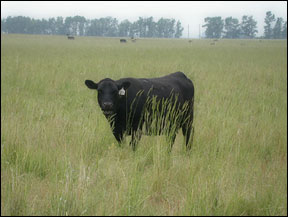 1 – Economically: Grazing plans allow managers to generally forecast whether there will be too much, too little, or an adequate amount of forage available for grazing animals. This provides the advanced ability to determine re-stocking and/or de- stocking strategies prior to “out of grass” situations and poor market conditions when everyone else selling. Most importantly, proper planning can increase profit, primarily through improved animal performance and elevated nutritional plains, increased herd immunities, decreased human & animal stress, and higher reproductive performance at less cost. Furthermore, approved grazing planning documentation will be critical relative to larger global issues such as carbon sequestration and carbon credit payments in the future.
1 – Economically: Grazing plans allow managers to generally forecast whether there will be too much, too little, or an adequate amount of forage available for grazing animals. This provides the advanced ability to determine re-stocking and/or de- stocking strategies prior to “out of grass” situations and poor market conditions when everyone else selling. Most importantly, proper planning can increase profit, primarily through improved animal performance and elevated nutritional plains, increased herd immunities, decreased human & animal stress, and higher reproductive performance at less cost. Furthermore, approved grazing planning documentation will be critical relative to larger global issues such as carbon sequestration and carbon credit payments in the future. 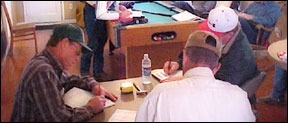 2 – Ecologically: Advanced grazing management planning allows the processes of Nutrient and Water cycling to better hold soil moisture and increase fertility. Biologically, plant and animal communities function better, which includes improved large and small wildlife habitat and riparian system function. Additionally, Energy Flow (production) can be drastically improved with proper grazing planning as well.
2 – Ecologically: Advanced grazing management planning allows the processes of Nutrient and Water cycling to better hold soil moisture and increase fertility. Biologically, plant and animal communities function better, which includes improved large and small wildlife habitat and riparian system function. Additionally, Energy Flow (production) can be drastically improved with proper grazing planning as well. 3 – Socially: Grazing plans provide a sense of control and peace of mind for on-the-ground mangers. In some cases, planned grazing documentation is a requirement for federal, land trust, or private leases. More and more grazing plans are becoming the industry standard.
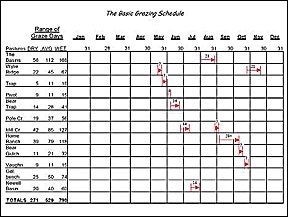 What Is a Grazing Plan?
What Is a Grazing Plan? A grazing plan is basically a list of pastures that includes a calculated range of grazing days (based on herd demand and forage supply) that are meshed within a 6-12 month calendar. The sequence of grazing use for each pasture can be determined and considered relative to known constraints (branding, weed issues, water limitations, etc.).
The Fundamentals of Forage Supply and Demand
The goal of any profit-driven grazing manager should be to accurately balance the forage demand of the herd (burn rate) with the available forage supply, while still leaving adequate residual.
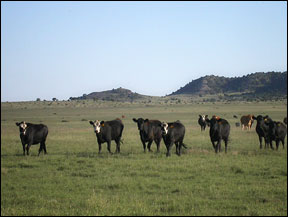 DEMAND (burn rate)
DEMAND (burn rate) The most effective way to express daily individual forage demand is to consider it on a lbs/day basis. Though consumptive rates can vary from 2-4% of body weight (based on physiological needs, weight, and forage quality), it is safe to assume that most grazing animals need from 2.5% to 3.5% (on a dry matter basis) of their body weight in forage per day. For example: to maintain body condition, a 1200 lb. non-lactating cow needs about 2.5% of her weight per day = 30 lbs/day. That same cow, now lactating with a young calf at her side while trying to reproduce, needs 3% of her body weight in forage a day = 36 lbs/day. Three months later, that cow/calf pair (calf is sucking & grazing) now collectively will require about 45 lbs forage per day (1200 lb cow + 300 lb calf = 1500 lbs x 3% = 45 lbs / day).
It is the manager’s job to be aware of, plan, and provide for these needs.
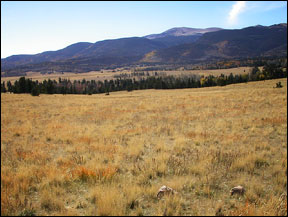
ADa (Animal Day / acre) rating is defined as the number of animals that could graze on one acre for one day and still leave the desired residual. Example: 10 ADa rating = 10 animals on one acre for one day.
The amount of forage that is available to livestock (or wildlife) depends on a number of factors:
1) The type and desirability of plants present (relative to the type of grazing/browsing animal)
2) Seasonal growing conditions (favorable vs. unfavorable)
3) The condition of the plant / soil ecosystem (well functioning vs poor functioning)
4) The terrain (flat vs steep)
5) Distance from water
Managers in the west typically use a rating system of Acres / AUM (number of acres required to feed one animal for one month) to relate forage supply. For example: 300 AUMs = 150 hd for 2 months of grazing, 100 hd for 3 months, 300 hd for 1 month, etc. However, we suggest an approach which is more straightforward and useful to managers: lbs / acre. This figure can quickly translate into the very useful Animal Days of Grazing per Acre (ADa) rating which is similar in concept to traditional “Acres / AUM”, but is easier to use because it considers days not months.
 RESIDUAL (leaving enough behind)
RESIDUAL (leaving enough behind) Before continuing with ADa ratings, it is imperative for the grazier to understand the importance of planning for how much forage should remain in the pasture at the end of the grazing period and/or grazing season. Many people talk about utilization (% of forage removed), but from a land manager’s perspective it is psychologically more important to view this in the opposite light and focus on the % of forage remaining. This is known as the residual forage, or just residual.
In areas where production is less than 2000 lbs / acre, leaving at least 50% of total seasonal production is a long-held and common goal. In higher producing areas, leaving 1000 – 1500 lbs / acre is probably adequate. There are situations however, when leaving 60%-100% may be appropriate such as: 1) Pastures are ecologically poor functioning, 2) In drought conditions 3) Too much bare soil exists, and/or 4) Adequate basal or litter cover is low.
Calculating Time Available to Graze using Supply and Demand principles
Question: How many days of grazing are available in a 200 acre pasture, based on the following information?
1200 lb dry cows, maintenance diet desired, 320 in herd good pasture condition, 600 lbs/a forage production
Answer: 6.25 days
Here are the calculation steps: 1) 1200 lb cow x .025 (percent body weight) = 30 lbs / day forage needed
2) 600 lb/as grass production – 300 lbs/a (50% to leave as residual) = 300 lbs available to graze
3) ADa Rating = 300 lbs avail – 30 lbs / day = 10 Animal Days / Acre rating
4) 10 ADa x 200 acres = 2000 Animal days grazing
5) 2000 AD’s – 320 animals = 6.25 days of grazing while still leaving 50% residual
Final Thoughts
Good grazing management requires an understanding of overgrazing and how it can be avoided. Livestock don’t overgraze, managers do. The keys to using grazing to improve the land include maintaining short grazing periods (relative to growth rates), leaving adequate residual following grazing, and allowing the proper amount of root growth and/or plant recovery following grazing. Finally, it is important to understand that a grazing plan followed with monitoring and good record keeping are vital management tools for the progressive, profit-driven farm/ranch manager.
How do I record and manage my grazing data?
If you have taken a Land EKG Grazing Planning Workshop, you have blank worksheets (Sheets A through J) in the back of your handbook, which you can photocopy. For everyone else, if you need some blank worksheets, contact us at the office. You may also want to consider attending one of our Grazing Planning Workshops where you will develop hands on skills and confidence in determining forage production, rangeland condition and appropriate stocking rates.
IN OUR NEXT LAND EKG E-NEWSLETTER ISSUE:
Enough Recovery? Ask the Land
If you have any suggestions for future issues, have feedback, or want more information please contact us at:
(307) 366-2445 or contact us by email.
Thanks for reading. HAPPY PLANNING!
